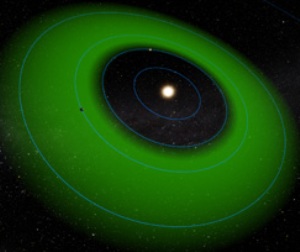Scientists find two Earth-like habitable exoplanets in 'Goldilocks' zone
 Washington, Jan 7 - Astronomers have revealed that they have found eight new planets in the " Goldilocks" zone of their stars, orbiting at a distance where liquid water can exist on the planet's surface, including two that are the most similar to Earth of any known exoplanets to date.
Washington, Jan 7 - Astronomers have revealed that they have found eight new planets in the " Goldilocks" zone of their stars, orbiting at a distance where liquid water can exist on the planet's surface, including two that are the most similar to Earth of any known exoplanets to date.
Lead author Guillermo Torres of the Harvard-Smithsonian Center for Astrophysics (CfA) said that most of these planets have a good chance of being rocky, like Earth.
The two most Earth-like planets of the group are Kepler-438b and Kepler-442b. Both orbit red dwarf stars that are smaller and cooler than our Sun. Kepler-438b circles its star every 35 days, while Kepler-442b completes one orbit every 112 days.
With a diameter just 12 percent bigger than Earth, Kepler-438b has a 70-percent chance of being rocky, according to the team's calculations. Kepler-442b is about one-third larger than Earth, but still has a 60-percent chance of being rocky.
Kepler-438b receives about 40 percent more light than Earth. (In comparison, Venus gets twice as much solar radiation as Earth.) As a result, the team calculates it has a 70 percent likelihood of being in the habitable zone of its star.
Kepler-442b get about two-thirds as much light as Earth and the scientists give it a 97 percent chance of being in the habitable zone.
As with many Kepler discoveries, the newly found planets are distant enough to make additional observations challenging. Kepler-438b is located 470 light-years from Earth while the more distant Kepler-442b is
1,100 light-years away. (ANI)